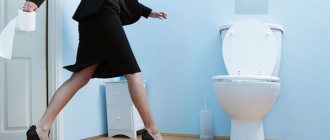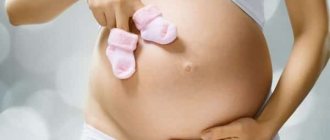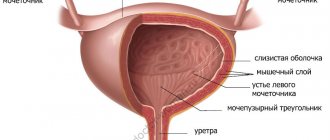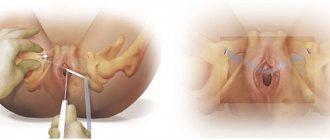Sneezing incontinence is a stressful form of the disease. It occurs against the background of weakening of the pelvic floor muscles after childbirth, operations, and heavy physical labor. Urine leaks spontaneously: incontinence occurs when coughing, laughing, lifting heavy objects, or unexpected straining. The woman feels insecure, refuses to meet with friends, and is embarrassed to wear tight clothes. Not everyone decides to tell the doctor about the problem.
Regardless of the cause of urinary incontinence when sneezing in women, treatment must be carried out in any case. No home methods will help if the genitourinary organs are prolapsed and the functions of the sphincters are impaired. The doctor will conduct an examination, prescribe an examination and decide on further tactics.
Urinary incontinence: clinical picture
Involuntary discharge of urine (incontinence) is a completely uncontrollable process and occurs without any warning. The provoking factor for such an act of urination is most often physical stress caused by coughing, sneezing or laughing. The sudden release of urine occurs regardless of human biological rhythms.
Urinary incontinence in women due to coughing is much more common than in men. The disease mainly spreads among pregnant women and women who have undergone menopause. Men may suffer from sneezing and urinary incontinence after 60 or as a result of a previous disease of the genitourinary system.
Types of incontinence in women after 40 years
Stress urinary incontinence is most common in women over 40 years of age. In this condition, it is impossible to control bladder emptying when intra-abdominal pressure increases. With any tension that occurs during coughing, sneezing, lifting heavy objects, or intimacy, urine can leak or even spill out in large quantities, causing a feeling of discomfort. Normally, the sphincter and pelvic floor muscles prevent urine from spontaneously releasing during physical exertion. But when muscle fibers weaken, this function is impaired.
Sometimes women experience urge incontinence, which is manifested by an unbearable urge to urinate. The desire to empty the bladder does not arise when it is completely full, but even when urine accumulates in small quantities. Unbearable urges can be provoked by the sound of pouring water or physical activity. When the bladder prolapses, pain occurs in the lower abdomen. Constant leakage of urine leads to exacerbation of thrush, skin dermatitis, frequent relapses of vulvovaginitis and genitourinary infections.
Iatrogenic incontinence occurs due to the use of certain medications. Urine ceases to be excreted spontaneously after discontinuation of these medications. Adrenergic agonists, diuretics, adrenergic blockers, estrogen-based hormones, and sedatives can provoke the development of the process.
Causes of urinary incontinence in women after 30 years of age, treatment of the disease.
Causes of urinary incontinence in women after 50 years of age, principles of treatment of the disease.
Diagnosis of incontinence in women after 40 years
An incontinence examination is prescribed by a doctor to assess the condition of the genitourinary organs and make an accurate diagnosis. During diagnosis, the following procedures may be prescribed:
- Ultrasound of the pelvic organs;
- cystoscopy;
- urodynamic examination;
- microscopic examination of smears;
- general and bacterial urine tests.
The doctor may ask the woman to keep a voiding diary. After receiving the diagnostic results, specialists can determine the type of incontinence and prescribe treatment.
Principles of treatment of female incontinence
Incontinence is one of the most delicate problems addressed to urologists and gynecologists. These specialists often work together, since urine leakage is often combined with genital prolapse, uterine prolapse and vaginal wall prolapse.
An effective conservative treatment method is the use of urogynecological pessaries, which eliminate signs of incontinence and uterine prolapse. Such designs are widely used in urological and gynecological practice. This is due to the absence of the need to carry out complex surgical interventions, which do not always completely solve the problem.
Urogynecological pessaries are known to be considered a classic option for the correction of prolapse and incontinence in women of all ages. The products are made from hypoallergenic materials that do not react in any way with the mucous membrane.
Conservative therapy may also include:
- getting rid of excess body weight, which puts excess pressure on the organs of the genitourinary system;
- avoiding caffeine-containing drinks that can cause increased urination;
- carrying out special exercises for the pelvic floor muscles, Kegel exercises;
- timely treatment of infectious and inflammatory diseases of the pelvic organs;
- taking sedatives (for increased anxiety);
- treatment of chronic cough, constipation;
- avoidance of heavy lifting and excessive physical activity.
Surgical treatment of urinary incontinence in women after 40 years of age is carried out when conservative methods are ineffective. The most common are sling surgeries, which are less traumatic. Using a special loop, the surgeon fixes the bladder and supports the urethra in the desired position. It is also possible to perform colporrhaphy or laparoscopic surgery, the purpose of which is to suspend and suturing the tissue in the area of the inguinal ligaments.
Our silicone urethral cup pessaries are an effective measure for the prevention and treatment of urinary incontinence. The products have passed all the necessary clinical tests and have all the necessary certificates and permits.
Causes and provoking factors of the disease
Causes of urinary incontinence when coughing are usually caused by the following problems:
- excessive emotional stress, frequent stressful conditions;
- overweight;
- complications during pregnancy and childbirth;
- consequences of surgical interventions;
- hormonal imbalance;
- suffered severe injuries;
- smoking, alcohol abuse.
Occasional urinary incontinence in children when laughing is considered normal. Incontinence when laughing in boys is observed in 28% and usually disappears by the age of 5. And in adolescents, the incidence rate is reduced to 5%.
Urinary incontinence when laughing occurs in girls if they suffer from obesity or overactive bladder syndrome.
Kegel gymnastics: a detailed guide
Kegel exercises are designed specifically to strengthen the pelvic floor muscles in women. It is most effective to carry it out with a “Kegel Trainer” (small vaginal balls), but for the first time you can try without them. Follow this instruction:
- Take a comfortable position and tighten your vaginal muscles so that you feel pressure in the pubic area. Keep your muscles tense for 3 seconds, and then take a break of 5 seconds. Continue to the next exercise.
- Tighten the sphincter and vaginal muscles as if you want to go to the toilet. If you have experienced childbirth, you can remember the efforts you made during this. Hold the muscles in this state for 5 seconds, and then take a break.
- Slowly pull the vaginal muscles inward so as to avoid jerking and jerking movements. The exercise is done for 5 seconds. In the first second your muscles should be completely relaxed, and by the fifth second they should be contracted. Repeat in reverse order and take a break.
Note! Treatment with Kegel exercises can only be carried out if the muscles have not been injured after childbirth or surgery. Go through the recovery phase.
Features of the disease in women
Women become hostages of this situation much more often than men, this is due to the anatomical features of the female body.
The degree of stress experienced during pregnancy plays an important role. Urinary incontinence during coughing during pregnancy is a temporary phenomenon if subsequent hormonal changes do not worsen the situation. Discharge of the urethra when coughing after childbirth cannot be called the norm, because it can be one of the harbingers of serious infectious diseases.
Characteristics of symptoms
You can answer the question why urinary incontinence occurs when you cough by studying the types of involuntary urination.
- Stress incontinence. It develops more often in women due to decreased muscle tone of the pelvis. Clinical manifestations: urinary incontinence during coughing, sneezing, laughing or running.
- Urge incontinence. In this case, the urge to urinate occurs arbitrarily, and it is simply impossible to restrain them. The cause is an overactive bladder. A provoking factor for urination may be the sound of dripping water, a nervous state, or the consumption of alcoholic and coffee drinks. Symptoms may worsen during the cold season.
- Overflow incontinence. Characteristic of the male gender. The cause may be a neoplasm of the prostate gland. In this regard, there is a violation of the outflow of the urethra and overflow of the bladder, which cannot cope with a large volume of fluid.
The main causes of pathology
The problem in old age arises against the background of one or several reasons. The most common factors that provoke involuntary leakage of urine:
- hormonal imbalance;
- infections affecting the urinary organs;
- obesity;
- weakening of the pelvic muscles;
- diabetes;
- bladder stones;
- history of surgery;
- mental disorders and neurological pathologies;
- spinal cord tumor;
- uterine prolapse;
- prolapse of the bladder;
- depression;
- taking diuretics and large volumes of fluids;
- excessive consumption of soda, alcohol, tea and coffee.
Basic diagnostic methods
Concluding a diagnosis, carrying out therapeutic measures and preventive measures are the sphere of competence of more than one specialist. A urologist, gynecologist or neurologist can treat urinary incontinence when coughing. Due to the fact that this problem may not relate to an independent disease, but only be a symptom of it, therapeutic methods of managing the patient will be different.
Depending on the specific situation, the following diagnostic methods are used.
- Keeping a urination diary, in which the patient carefully records the amount of fluid drunk and excreted, the frequency and nature of urination.
- Visual examination for the presence of concomitant pathologies, which may be preceded by varicose veins, the presence of stretch marks in the abdominal area, hernia formations and layers of fatty tissue.
- Laboratory studies to exclude the development of infectious and inflammatory processes.
- Ultrasound examination to visualize the condition of the urethra.
- Functional tests will allow us to establish the fact of the disorder and identify its provoking factor.
- Purpose of urodynamic studies: cystomanometry and uroflowmetry.
Silencing problems and harmful myths
Urinary incontinence occurs in approximately 30% of women and 15% of men, but the statistics are obviously underestimated. Many patients do not receive treatment and do not report the problem to doctors. Because of this silence, we delay treatment and continue to believe common myths about voluntary urination. Test your knowledge:
- voluntary urination occurs only in older people and children . Of course, it is more difficult for muscles to hold back urine at the age of 60, as age-related changes in the structure of muscle tissue take effect. On the other hand, a person of any age is not immune from this;
- spontaneously leaking urine is a disease. Not a disease, but a symptom. Incontinence can be caused by diseases of the genitourinary system, impaired brain function, and even lack of physical activity. There are many reasons;
- Urinary incontinence after pregnancy is permanent. If you do not monitor the condition of your pelvic floor muscles and do not undergo rehabilitation, yes. In other cases, this problem is easy to get rid of;
- incontinence means bed rest. Not at all. There are urine absorbent pads with antibacterial effect that will help you lead a normal life while undergoing treatment. No harm to hygiene;
- Spontaneous urine is not treatable in old age. There is a way out even in the most extreme cases. You can, for example, monitor urine using a special system. An artificial muscle is created. Modern technology is capable of this;
- people with incontinence always smell bad . Another myth. According to statistics, 30% of women you know aged 40–60 have encountered this problem. Of course, it is not customary to talk about it. Modern urine pads are invisible under clothing and block unpleasant odors.
If you have dispelled fears and prejudices, you can freely consider the problem of the inability of organs to hold urine and find the right solution.
Methods of treating the disease
Medication prescription
One of the most effective methods of treating incontinence is considered to be medication. For urinary incontinence when coughing, tablets are prescribed depending on the severity of the disease, taking into account the individual characteristics of the patient’s body.
Table: Drug treatment of urinary incontinence during laughter, coughing and sneezing
| Drug group | Estimated effect | Drug name |
| Anticholinergics | Reducing sphincter spasm |
|
| Hormones | Increased estrogen levels |
|
| Nootropics | Stabilization of the functioning of the nervous system |
|
| Antimicrobial | Suppression of inflammatory processes |
|
Physiotherapeutic ways to combat the disease
For opponents of drug treatment, the question: what to do in case of urinary incontinence when sneezing remains relevant. In this case, you can try physical therapy. The most popular in medicine are:
- darsonvalization - affects the walls of the bladder, helping to stabilize its functioning;
- electrosleep – promotes relaxation of the central nervous system;
- electrophoresis - has a relaxing effect and relieves inflammatory processes.
Surgical intervention
Elimination of symptoms of urinary incontinence during laughter in women and men through surgery is quite rare. This pathology responds well to drug treatment, so surgery is performed only if the main treatment tactics have not brought a positive result.
One of the options for surgical intervention is possible.
- Sling method. The essence of the operation is the implantation of special silicone loops instead of weakened muscles, with the help of which the urethra is fixed.
- Anterior colporrhaphy. The technique is aimed at preventing sagging of the urethra by tightening the vaginal muscles. The operation is performed in two ways: through the vagina and through the abdominal cavity. The first option is more gentle and requires a shorter rehabilitation period.
- Botox injections. They are made into the walls of the bladder, helping to minimize its irritability and involuntary contraction. This operation should be repeated every six months, since the drug tends to dissolve.
Treatment of incontinence with folk remedies
When solving the problem of how to treat urinary incontinence when coughing, you should not neglect alternative medicine. For preventive purposes and as an additional therapy to the main course of treatment, folk remedies can be used.
- Dill seeds are a natural diuretic and antispasmodic that prevents uncontrolled contractions of the bladder walls. To prepare the decoction 1 tbsp. pour a spoonful of seeds into a glass of boiling water and leave for 6 hours. It is recommended to take the prepared product in the morning before meals.
- St. John's wort and centaury. A third of a glass a day, brewed with one tablespoon of herb, has a pronounced diuretic, anti-inflammatory, and antispasmodic effect.
- Corn silk. The infusion relieves inflammation and has diuretic properties. For infusion 1 tsp. The stigmas are brewed with a glass of boiling water for 30 minutes. Drink in small sips throughout the day.
Treatment
Most women who have given birth and undergo postpartum rehabilitation in a specialized center do not experience incontinence in later life. Rehabilitation is aimed at psychological support, excess weight loss and, of course, rehabilitation of the pelvic floor muscles. If the problem makes itself felt, conservative treatment is carried out in the following ways:
- "Kegel trainer" It is best to use vaginal trainers equipped with a display and pressure gauge. With their help, a woman can track the results of intimate gymnastics;
- electrical stimulation. The muscles and nerves that hold urine are stimulated by an electrical signal of a certain magnitude and amplitude. Forced muscle contraction occurs and lymph flow improves.
One session of electrical stimulation treatment lasts 20 minutes, and the course consists of 10–20 sessions. With electrical stimulation with biofeedback, a sensor is inserted into the vagina or rectum, which analyzes the force of contraction of the muscles responsible for the restraining function. If this force is insufficient, the device amplifies it using an electrical pulse. At the same time, the patient’s brain “remembers” the required contraction force to hold urine. The procedure is completely painless.
Electrical stimulation treatment costs several times more than a Kegel exercise machine. They resort to it when it was not possible to achieve results using the first method.
Diet
Correction of the severity of the disease can be carried out by following basic nutritional rules until all symptoms of the disease disappear.
To do this, it is necessary to exclude those foods in the diet that irritate the bladder and provoke its contractions. These include:
- alcoholic and coffee drinks;
- sparkling water;
- spicy dishes;
- citrus;
- milk products.
It is mandatory to adhere to the drinking regime during the diet. The general recommendation is approximately 2 liters of purified water.
Which doctor should I contact for urinary incontinence?
A gynecologist and urologist will help you make a diagnosis. The examination proceeds as follows:
- "Diagnosis by cough." Your healthcare professional will ask you to cough or tense your lower abdominal muscles. If urine is leaked during this, the diagnosis of incontinence is positive.
- Vaginal and cervical smears. This method allows you to rule out diseases that could lead to problems with urinary retention. For example, cystitis. Urine is also taken for analysis.
- Ultrasound of the kidneys and bladder. If there is a suspicion of tumors, inflammation or urolithiasis, ultrasound will help to accurately determine the causes of the inability to hold urine.
Doctors usually give a positive prognosis when using conservative treatment methods. If the situation has not improved after a year, treatment is carried out through surgery - installation of a synthetic loop. The operation is performed for any degree of incontinence and is performed under local anesthesia.
Use of urological underwear
Urological underwear will help to minimize the negative impact of incontinence on the quality of life. These are special panties and pads that have absorbent properties. They are not able to solve the problem of urinary incontinence due to severe coughing, but they will allow you to get rid of discomfort and make it possible to lead a normal lifestyle.
Hygienic panties are selected taking into account the individual course of the disease and correspond to the degree of absorption of the secreted fluid.
Urological underwear is very comfortable, invisible under clothing, does not irritate the skin and has bactericidal properties, which prevents the development of painful complications.
Rules of intimate hygiene during treatment
Conservative treatment will take a maximum of a year. At this time, you will have to pay increased attention to intimate hygiene to protect yourself from genitourinary tract infections. Use urine absorbent pads. Important parameters of the funds:
- ability to absorb urine. The quality of absorption is indicated by markers from the 1st to 4th stages. Stage 4 is for severe incontinence and the product can absorb up to 500 ml of urine;
- odor neutralization. Pads that block the unpleasant odor that comes from contact of urine with bacteria will allow you to feel relaxed;
- antibacterial effect upon contact with urine. Choose hygiene products that replicate the normal acidity of the skin - 5.5 pH. Such acidity is destructive to pathogenic microorganisms and does not cause irritation upon contact with the epidermis;
- shape and comfort. Models with anatomical structure are given priority. They are practically invisible under clothing and do not cause discomfort.
Do not try to use period pads as pee pads. The pads we use during menstruation are not designed to absorb large volumes of low-density fluid. Try pouring a glass of water on it before use to see for yourself and avoid getting into an awkward situation. Think of it as urine. It flows freely over the surface without having time to be absorbed.
Preventive measures
To prevent incontinence, it is recommended to adhere to the following recommendations:
- with a dry cough, urinary incontinence most often occurs as a result of smoking - you should immediately give up the bad habit;
- systematically visit a medical facility to detect the disease at an early stage;
- monitor your weight, follow the recommendations of proper nutrition;
- avoid frequent constipation;
- control the consumption of drinks that have an irritating and diuretic effect;
- limit physical activity;
- observe the drinking regime.
Only a competent specialist can assess the severity of the disease and answer the question: what to do in case of urinary incontinence when coughing.







